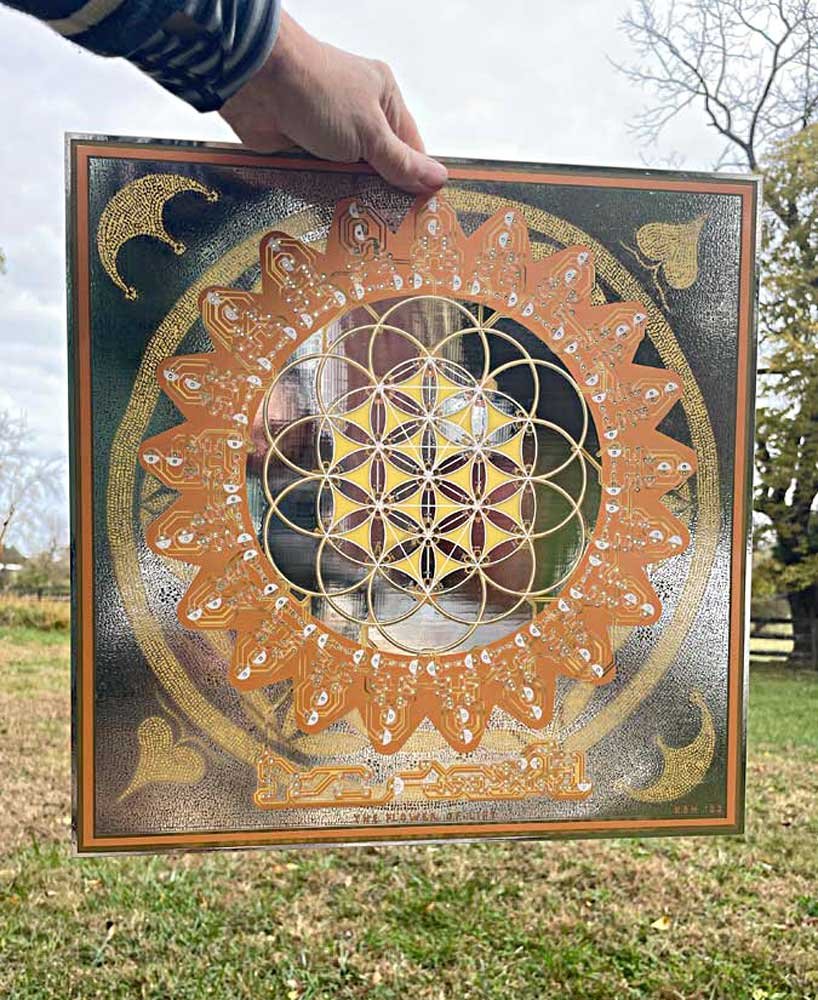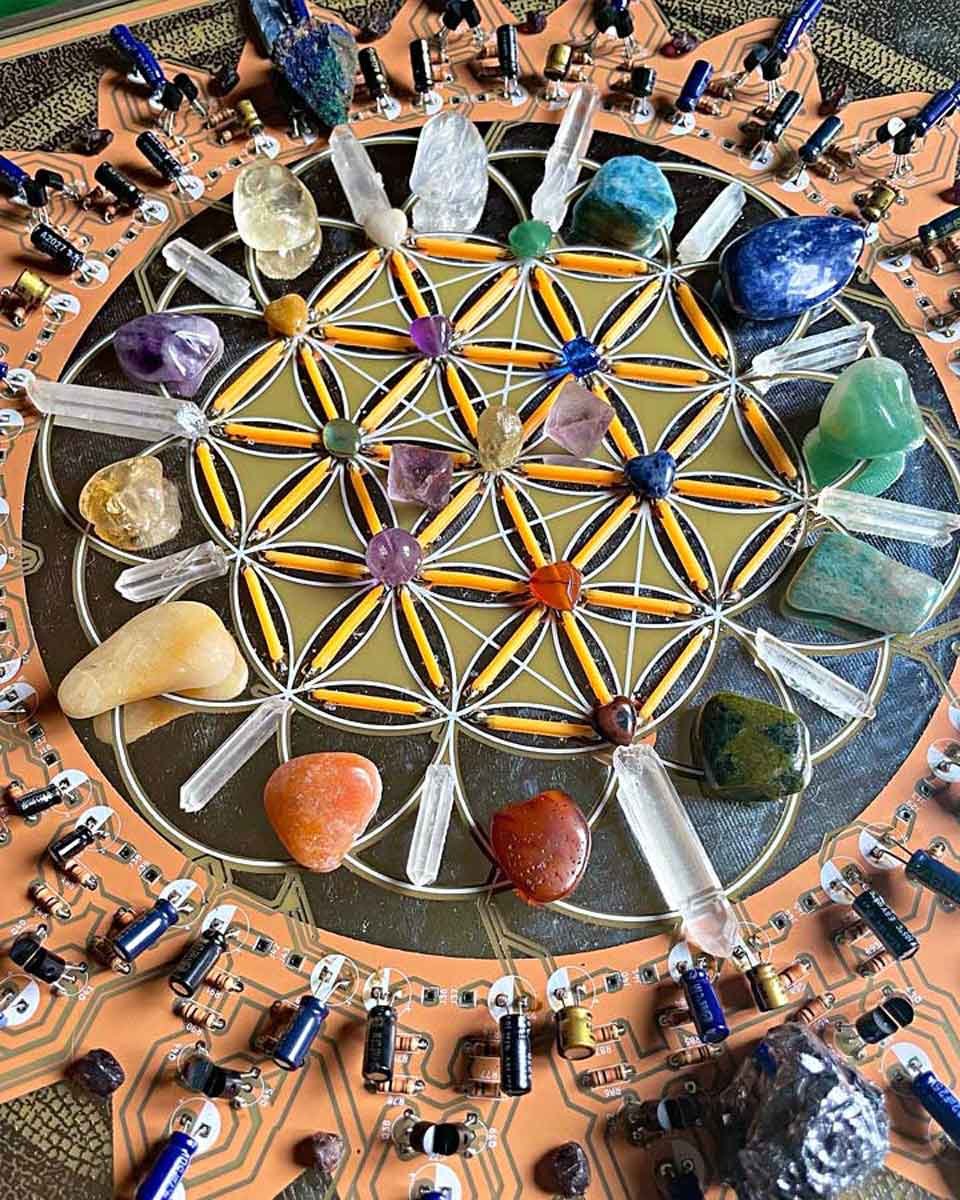THE FLOWER OF LIFE, 2022
CRYSTAL GRID
“We can’t understand the universe in any clear way without the supernatural.”
ETCHED COPPER LAMINATE
“And, suddenly, the flower emerges not as this pretty object to be admired, but as this ravishing system of aliveness — a kind of silent symphony of interconnected resilience. ”
The Flower of Life is a symbol of universal creation. I explain my inspiration and process in this video created for the MIT Media Lab class “Ancient Future Technology” (taught by David Kong, Fall 2022). https://vimeo.com/780806914
Additional video links:
Crystal Grid: https://vimeo.com/777130694
Circuit board printmaking (removing the vinyl mask to reveal the etched copper on paper): https://vimeo.com/780821822
Printed Circuit Board manufacturing by King Credie in Shenzhen, China: https://vimeo.com/779747244
PROJECT DESCRIPTION
The Flower of Life is an archetype for the cycle of universal creation. It is an ancient and universal form of sacred geometry with profound resonance for ceremonial practice and meditation. The Seed of Life and the Kabbalistic Tree of Life are both contained within its interlocking circles, making it a powerful symbol for past, present, and future life. The Flower of Life speaks to the circular relationship between humans, technology, and nature wherein we are part of an existing nature and creating a new nature - simultaneously. My “Flower of Life” project connects ritual, printmaking, and electrical engineering to invent a new form of art.
My Flower of Life Crystal Grid is a printed circuit board with sacred geometry, crystals, and vibration that is used for ceremonial meditation. The circuit has 21 oscillators (in the shape of flower petals) that vibrate in an analog electronic mesh. A microphone picks up ambient sound and feeds it into the vibrating flower, thereby connecting the art with its environment — like a real flower trembles in the breeze. Even though my art isn’t alive in the same way as a biological flower, its unpredictable and responsive patterns of electricity feel life-like to me.
Inspired by the sand mandalas of Buddhist monks, I set-up my Flower of Life as a crystal grid. I wanted to see (or feel) how the vibration would change in the presence of naturally occurring minerals. After all, crystals such as silicon, gallium, and quartz are the material foundation of electronic technology.
I am pleased to report that the combination of ritual engagement, rock crystals, and electrical vibration do create a distinct presence, something like a special electromagnetic field for setting intention.
It’s not easy for me to work with circuits as an artist because electrical engineering is biased towards science, industry, and consumer products. But I want an emotionally intimate relationship with technology, and circuits are the most direct means I know to make art with electricity. Circuits feel like magical sculpture to me. By contrast, software is a linguistic medium that is several layers removed from the physical body an electronic device. Circuits have a raw, authentic presence that I don’t find in the virtual reality of my computer.
It’s exciting, after many long hours designing a circuit, to receive boards from the factory. There’s something really satisfying about turning virtual design documents into a real physical form. Still, I find factory-produced circuit boards hard to love because they look, feel, and even smell severe. Circuits can have that unemotional, utilitarian quality of an object made by thinking and logic instead of intuition and heart. I feel this way about most forms of electronic technology, and I don’t like it.
For years, I’ve been dreaming about etching my own circuits on traditional artistic media like paper or canvas. There is a long history with copper etching in art, but usually to make the plates for printmaking. In other words, we don’t actually see the etched copper because it’s just a tool for making the print. With my printed circuit boards, I want etched copper to be a central compositional element of the art. I am inspired by Richard Serra’s heavily worked drawings because they highlight the nature and struggle to work with raw, elemental materials.
Printmaking is a technically demanding process, and for a long time this barrier prevented me from trying to etch my own. But finally I realized that the imperfections of making an object by hand were precisely what I felt was missing in technology. The so-called “imperfections” of an artist’s material process actually contain the human qualities that I wanted to see in electronic art. By accepting and working with the imperfections of my etching process, I discovered a deeper and more meaningful relationship with technology. I came to appreciate my layers of process, the residue of chemical stain on the paper, the tarnish and patina on the copper. I began my project intending to solder the circuit with electronics but decided to let these initial works be drawings and process documents of my journey.
When I make a work of electronic art, people often ask me “well, what does it do?” In this case, my answer is “it does art.” That’s it: it just does being a work of art.
Satnam.
Kelly Heaton, December 2022
DIGITAL ARTIFACTS
Images that I discovered while designing the printed circuit board, a multi-layered file made in KiCad, Illustrator, and Photoshop
etching PROCESS
Early experiments etching 1ounce copper sheet glued to paper or canvas. My etchant is ferric chloride that I applied in small amounts using a brush and later neutralized with baking soda. The purple film is a UV resist, and the yellow is a vinyl mask that I cut with a machine to reproduce the flower of life sacred geometry and circuit traces.





























